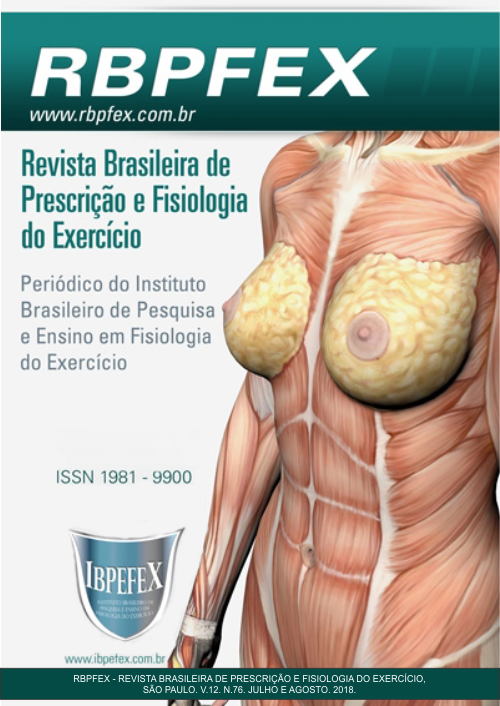Neuromuscular responses to sprints training
Abstract
High-intensity interval training (HIIT) has high relevance in sports physical preparation and has increased in popularity in gyms. In this sense, the present study aimed to evaluate the effect of a Sprint Interval Training (SIT) session on neuromuscular variables. For this, 11 university students, of both sexes, aged between 20 and 32 years old were part of the sample. The students underwent a battery of tests containing a 10m speed test (V10m), horizontal jump (SH) and Medicine Ball throw (AMB), in the PRE, POST and 48h POST SIT session, which was performed through run on flat terrain and consisted of 3 Sprints of 20s in All-out mode for 2min of passive recovery. After the Shapiro-Wilk normality test, the data are presented as mean ± SD. For comparisons between moments, ANOVA for repeated measures with post-hoc Bonferroni was applied. And, for the correlations between the variables, Pearson's coefficient was used. The results showed that SIT negatively affects V10m (F=14.9; η²= 0.59; p= 0.001) immediately after training and that this deleterious effect remains for 48h (p=0.004). The effect on SH (F= 6.3; η²= 0.38; p= 0.007) does not remain after 48h (p=0.99), and only the period immediately after training is affected. Correlations were identified between height and performance in physical tests (r>0.7; p<0.02). Therefore, it is concluded that the SIT, performed in running form, requires longer recovery time for speed in relation to the power of the lower limbs and that the power of the upper limbs is not affected.
References
-Burgomaster, K.A.; Heigenhauser, G.J.; Gibala, M.J. Effect of short-term sprint interval training on human skeletal muscle carbohydrate metabolism during exercise and time-trial performance. American Physiological Society. Vol. 100. Num. 6. 2006. p. 2041-2047.
-Coledam, D.R.C.; Arruda, G.A.; Santos, J.W.; Oliveira, A.R. Relação dos saltos vertical, horizontal e sêxtuplo com a agilidade e velocidade em crianças. Revista Brasileira de Educação Física e Esporte. Vol. 2. Num. 1. 2013. p. 43-53.
-Coswig, V.S.; Ramos, S. D.P.; Del Vecchio, F.B. Time-motion and biological responses in simulated mixed martial arts sparring matches. Journal of Strength and Conditioning Research. Vol. 30. Num. 8. 2016. p. 2156-2163.
-Dupont, G.; Akakpo, K.; Berthoin, S. The effect of in-season, high-intensity interval training in soccer players. Journal of Strength and Conditioning Research. Vol. 18. Num. 3. 2004. p. 584-589.
-Ferrari Bravo, D.; Impellizzeri, F.M.; Rampinini, E.; Castagna, C.; Bishop, D.; Wisloff, U. Sprints vs. Interval Training in Football. International Journal Sports Medicine. Vol. 29. Num. 8. 2008. p. 668-674.
-Gibala, M.J. Molecular responses to high-intensity interval exercise. Applied Physiology, Nutrition and Metabolism. Vol. 34. Num. 3. 2009. p. 428-432.
-Gibala, M.J.; Mcgee, S.L. Metabolic Adaptations to Short-term High-Intensity Interval Training: A Little Pain for a Lot of Gain? Sports Medicine. Vol. 36. Num. 2. 2008. p. 58-63.
-Hoffman, J. Norms for fitness, performance and health. Champaing. Human Kinetics. 2006.
-Johnson, B.L.; Nelson, J.K. Pratical measurement for evaluation in physical education. Minneapolis. Burgess. 1979.
-Kruel, L.F.M.; Tartaruga, L.A.P.; Coertiens, M.; Oliveira, A.S.; Ribas, L.R.; Tartaruga, M.P. Influência das variáveis antropométricas na economia de corrida e no comprimento de passada em corredoras de rendimento. Motriz. Vol. 13 Num. 1. 2007. p. 1-06.
-Laursen, P.B.; Jenkins, D.G. The Scientific Basis for High-Intensity Interval Training Optimising Training Programmes and Maximising Performance in Highly Trained Endurance Athletes. Sports Medicine. Vol. 32. Num. 1. 2002. p. 53-73.
-Leite, R.D.; Neto, J.B.; Prestes, J.; Pereira, G.B.; Assumpção, C.O.; Magosso, R.F.; Pellegrinotti, I.L. Efeito de um programa de treinamento de 23 semanas nas variáveis antropométricas e neuromusculares em jovens nadadores. Revista Brasileira de Prescrição e Fisiologia do Exercício. São Paulo. Vol. 1. Num. 4. 2007. p. 96-105. Disponível em: <http://www.rbpfex.com.br/index.php/rbpfex/article/view/40>
-Macpherson, R.E.; Hazell, T.J.; Olver, T.D.; Paterson, D.H.; Lemon, P.W. Run sprint interval training improves aerobic performance but not maximal cardiac output. Medicine and Science in Sports and Exercise. Vol. 43. Num. 1. 2011. p. 115-122.
-Moreira, P. V. S.; Teodoro, B. G.; Resende, N.M.; Magalhães, A. M. Metabolismo no Futebol x Treino Intervalado. Revista brasileira de futebol. Vol. 4. Num. 2. 2011. p. 9-17.
-Ré, A.H.N.; Bojokian, L.P.; Teixeira, C.P.; Böhme, T.S. Relações entre crescimento, desempenho motor, maturação biológica e idade cronológica em jovens do sexo masculino. Revista Brasileira de Educação Física e Esporte. Vol.19. Num. 2. 2005. p. 153-162.
Authors who publish in this journal agree to the following terms:
- Authors retain the copyright and grant the journal the right of first publication, with work simultaneously licensed under the Creative Commons Attribution License BY-NC which allows the sharing of the work with acknowledgment of the authorship of the work and initial publication in this journal.
- Authors are authorized to enter into additional contracts separately for non-exclusive distribution of the version of the work published in this journal (eg, publishing in institutional repository or book chapter), with acknowledgment of authorship and initial publication in this journal.
- Authors are allowed and encouraged to post and distribute their work online (eg, in institutional repositories or on their personal page) at any point before or during the editorial process, as this can bring about productive change as well as increase impact and impact. citation of published work (See The Effect of Free Access).






